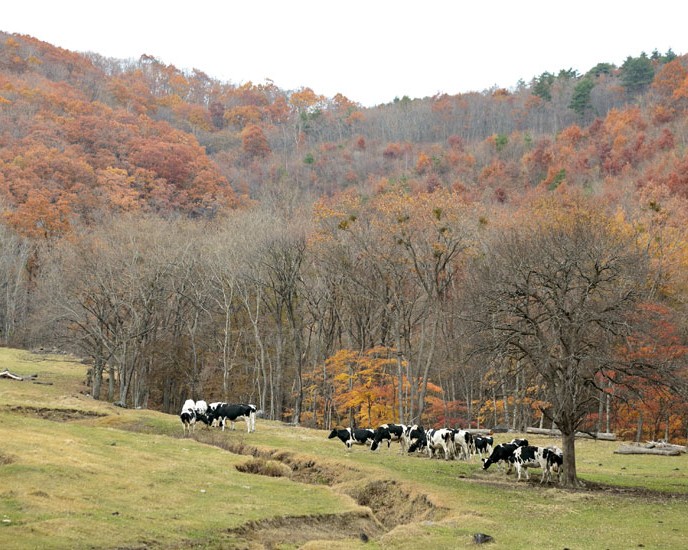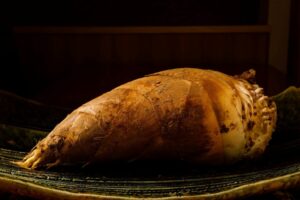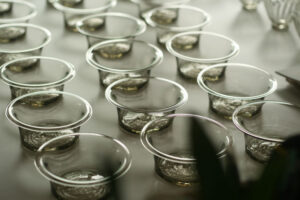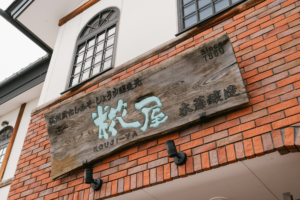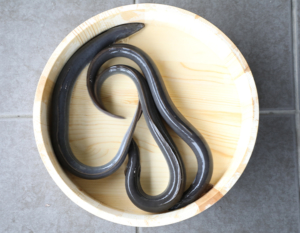“Mountain pasture dairy farming” refers to a dairy farming style where dairy cows are grazed year-round on mountain pastures (makiyama) and raised primarily on wild grasses such as Japanese fescue. Dr. Naobara Kyōji, a plant ecologist, proposed this dairy farming method, and Mr. Yoshizuka Kimio, the chairman of Tanohata Mountain Pasture Dairy Milk, has been practicing it. The milk produced is beloved by fans for its “seasonal flavors.”
Sustainable dairy farming that is good for cows, people, and nature

Mountainous areas account for approximately 70% of Japan’s landmass. By developing these areas to plant Japanese grass, a favorite food of cattle, and grazing Holstein cows, which produce large quantities of milk, it is possible to produce “milk” that leverages the vitality of these animals without relying on imported feed. This is the “mountain dairy farming” system proposed by Dr. Yasunari Yuhara, a plant ecologist known as the “God of Grass.” Cows, being herbivores, roam the sloping pastures in search of grass, feeding on wild plants like Japanese grass and drinking mineral-rich stream water, growing healthy and strong. Breeding and calving occur naturally. Additionally, their manure serves as fertilizer, sustainably nurturing Japanese grass and other native wild plants. As a result, dairy farmers can produce nutrient-rich milk without incurring costs for feed or fertilizer. There are also no costs for manure processing, including composting. Furthermore, Japanese grass has a high density, which helps prevent soil erosion during heavy rains and protects the mountains. In other words, mountain dairy farming is a sustainable dairy farming method that benefits both cows and people while enriching nature.
We want to share the wonders of mountain dairy farming.

Located in the northeastern part of Iwate Prefecture, Tanohata Village is a rural community where over 80% of the total area is covered by forests. Yoshizuka Kimio has been practicing mountain dairy farming here for nearly 50 years. At the 18-hectare Yoshizuka Farm, which features a rugged terrain, 18 milking cows and 10 growing cattle (calves and other cows that cannot be milked) are grazed year-round. The cows graze on pesticide-free and chemical-free wild grasses on the farm from spring to autumn, and during the winter when fresh grass is scarce, they are fed dried hay from the farm’s own pesticide-free and chemical-free pastures. They do not consume any grain feed.
“The wild grasses are native species, while the pasture grasses are varieties improved for livestock, so they are different types of grass. Fifty percent of the wild grasses on our farm are Japanese clover, and the remaining 50% include spring white clover and summer yarrow, among 49 other species. Additionally, the cows drink plenty of water in the hot summer and less in the winter. Therefore, customers who purchase our milk say, ‘The flavor is pure and clean, with no off-flavors, and you can enjoy the seasonal variations in taste,’” says Yoshizuka proudly.
Ten years of ‘lamp life’

Yoshizuka grew up in a salaryman family in Ichikawa City, Chiba Prefecture. During his elementary school years, he spent every summer staying at a farm where he observed the raising of Holstein cows, which sparked his interest in dairy farming. He went on to attend Tokyo University of Agriculture, where he was deeply inspired by Dr. Yuhara’s concept of “mountain dairy farming.” Determined to put this into practice and spread it across Japan, he spent a year apprenticing under his university senior, Mr. Kumagai Takayuki, who was already practicing mountain dairy farming in Tanohata Village. In 1977, he acquired 10 hectares of mountainous land within the village and settled there.
However, the area had no electricity, so for the first 10 years, they lived by lamp light. During this time, he cut down trees, planted Japanese cypress, fenced the area with wooden fences and barbed wire, and grazed Holstein cows to develop grasslands. This work continued for five years until he welcomed his wife, Toshiko, who had become malnourished. Electricity was finally connected in 1987. Yoshizuka reflects that this 10-year period was the toughest of his life.
Launching a private brand

He also endured financial hardship for a long time. This is because it takes more than 10 years for Japanese shiba grass to take root and stabilize in the soil. Additionally, in mountainous dairy farming, the number of cows per hectare of pasture land is limited to 1.5 head when converted to adult cows. Therefore, to increase the number of cows and produce and sell more milk, it is necessary to continue creating pasture land. In other words, there is no income during that period. Furthermore, even after gradually increasing the number of Holstein cows and finally securing milk production, Yoshizuka’s cows, which were not fed grain feed, sometimes failed to meet the milk fat content standards set by the agricultural cooperative, making the milk unsuitable for shipment. Even if the milk could be shipped, the proceeds were often offset by previous loans, leaving little cash in hand.
Therefore, after consulting with Kumagai, who was also shipping to the agricultural cooperative, they decided to launch a private brand and sell directly to consumers. Manufacturing was outsourced to the village’s industrial development corporation. Since the milk yield of Yoshizuka and Kumagai’s cows, which were not fed grain feed, was lower than that of cows fed grain feed, the milk had to be priced higher than regular milk. However, thanks to local television stations broadcasting the farm’s operations, customers who understood its value began purchasing it immediately after its launch in 1996. Many of those customers from the early days continue to purchase the milk today, and new customers are joining through word of mouth, so the fan base keeps growing.
“Increasing the number of mountain dairy farmers” is a dream shared by the father and son.

Since launching his private brand, Mr. Yoshizuka has been wearing two hats as a farmer and as president of Tanohata Yamachi Dairy Milk Co., Ltd., a sales company. However, in 2022, he handed over the reins of the farm to his eldest son, Kotaro, and the presidency of the company to his fourth son, Yuji. With dedicated personnel now in place for each role, both farm operations and company management have improved.
Creating dairy products that bring out the flavor of milk

Moreover, since 2017, Mr. Yuji has been producing yogurt, two types of cheese, and butter at his company’s dairy product workshop, “milk port NAO.” The yogurt is made using only lactic acid bacteria and fermented at low temperatures for an extended period, resulting in a mild acidity and a subtle richness in the aftertaste. Additionally, the cheese “Hakusen,” made with the company’s own fresh cream, offers the distinct flavors of both freshly made and aged cheese. Last year, the cheese won the “SUPER GOLD Award,” equivalent to first place in the soft cheese category at the “ARTISAN CHEESE AWARDS,” and has received recognition at various domestic and international competitions. “Dairy products with a longer shelf life than milk are easier to distribute, so I want to increase sales of these products to stabilize the company’s operations,” Yūshi says, revealing his determination.
The reason he has continued for 50 years without giving up

Although these three individuals have different roles, they share the same goal: to increase the number of mountain dairy farmers throughout Japan. In Japan, where land is scarce, dairy farming typically involves keeping cows tethered in barns and feeding them imported feed, which is cheaper than domestically produced feed but carries risks such as mold contamination. This method allows for efficient work on limited land and produces raw milk with a high fat content. “However, there are many abandoned mountain areas in Japan. By establishing mountain dairy farming there, despite the initial hardships of pioneering, both cows and people can eventually thrive, creating a sustainable farm that can be passed down for a thousand years, known as a ‘thousand-year farm,’ and supporting the local economy. Incidentally, the average lifespan of Holstein cows in Japan is 5–6 years, but at our farm, the oldest cow has lived to 16 years, and at Mr. Kumagai’s farm, one reached 18 years. And perhaps most importantly, the mountains are transformed into beautiful green pastures. Mountain dairy farming is the ultimate way to utilize Japan’s natural environment. That’s why, despite the hardships of pioneering and the economic difficulties, we’ve persevered without giving up,” says Yoshizuka. He aims to expand the farm to 30 hectares, increase the number of cows, and become an economically stable ‘model farm’ to realize this dream. Koutarou also aims to expand his farm, but his goal is to “make my son want to take over the farm.” On the other hand, Yushi is enthusiastic about accepting trainees. With many dairy farmers struggling due to rising feed and fuel costs caused by the weak yen and falling prices for calves, the dreams of these three men may also be the dreams of Japan’s dairy farming industry.



